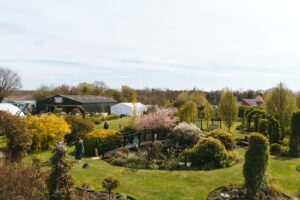Why a forgotten site in Manchester is finally proving fertile ground for regeneration

U+I development director, James Heather.
For a city that loves its own history as much as Manchester, ask many Mancunians where Mayfield Station is and it might elicit some head-scratching.
Yet it’s located a stone’s throw from Piccadilly Station, right in the heart of the city.
Since the last train left Mayfield in 1986, there have been various failed attempts to bring the 100-year-old former train station back into life, but none had stuck until now.
The Mayfield Partnership, which includes Manchester City Council, London & Continental Railways and Transport for Greater Manchester, invited bids in 2016 for a development partner. Regeneration firm U+I, who has a property portfolio worth almost £10bn, beat off fierce competition to develop the project.
It was a site that everyone knew the potential of.
U + I now plan to build a brand-new urban quarter, featuring 1300 homes, 800 sq ft of office space, a 350 room hotel, leisure and retail space and a centrepiece park.
New Start visited the site to meet development director James Heather, who hopes Mayfield will be a ‘total pivot’ of the city centre, away from other fertile grounds for regeneration such as Spinningfields and the Northern Quarter — but is it what Manchester needs?
Soul and character

Mayfield view from elevated platform.
Mayfield is a vast 30-acre site and includes the grand old redbrick railway arches and depot.
But rather than razing everything to the ground and starting from scratch, U + I were chosen because they were passionate about retaining some of Mayfield’s priceless heritage.
‘It wasn’t right to bulldoze everything and start again,’ says Heather.
‘Then you try and create soul and character — when it’s out there.’
‘It’s about what makes places human and having that connection with the past or recent history — people like to feel they are part of the place.
‘You can marry heritage into new stuff,’ he adds.
‘Manchester has constantly evolved and done things differently. It’s been at the forefront of innovation and that involves change.’
Public-Private Partnerships

Children from Medlock Primary School and Chris Boardman MBE visit pop-up DirtFactory at Mayfield, Manchester.
U + I is a strong believer in the oft-maligned public-private partnerships (PPPs). They published a report in November which called for a ‘reset’ of the relationship so they work better for community benefit.
But as the Haringey Development Vehicle fiasco saw, things can turn sour quickly, leaving the public left to pick up the bill.
Heather says PPP schemes go wrong because of a ‘lack of trust and honesty’ around forming the partnership, and key to the Mayfield Partnership’s success will be fostering a healthy relationship between the different partners.
‘Just like anything relationship, where PPP falls down and gets a bad name is because people aren’t as honest as when you go into it,’ he says.
‘You create promises you can’t honour and there is a disconnect.’
‘The U + I approach to partnership is a reinvention of the mode. You have the established stakeholders but also the wider community.’
So rather than close the site down, they’ve opened Mayfield up over the past couple of years and hosted eclectic ‘meanwhile use’ events from BMX competitions to experimental cinema screenings to street food festivals, and later this year it will host one of the city’s crown jewels, Manchester Gay Pride.
Heather says it’s a chance for U + I to garner opinions and ideas for the site from the people who make the city tick.
‘It’s not our job to force our answers onto a community — the meanwhile use is a good way to use that time sensibly whilst we wait to bring people to site.’
‘Mayfield is having a totally different approach to consultation that the city has ever seen before.’
Infrastructure

Mayfield from Baring Street.
Manchester City Council has been heavily criticised for the tiny number of ‘affordable’ homes they’ve allowed to be built in the city in recent years — yet cranes building the huge pipeline of new apartments dominate the skyline.
Last year, a report from Manchester Business School said Manchester faces a growing housing and transport crisis because of its ‘misguided’ developer-led regeneration approach.
The report argued that for the past 30 years planners have focused disproportionately on new urban buildings, leaving the city with under-developed transport infrastructure and social housing.
Manchester’s Liberal Democrat leader John Leach went further and recently described the Labour-led council’s approach to city centre housing as ‘social cleansing’.
So are more homes for affluent, urbane professionals really what Manchester needs?
This is the wrong way to look at city centre living, according to Heather, who was tight-lipped when pressed on how much social or affordable housing Mayfield will eventually have.
‘The city needs to mature in terms of its offer,’ he says.
‘Social housing is an issue in the city but people focus too tightly on what the city is,
‘You need more expensive houses and places for chief execs so that they can live in the city.’
‘But you also need to address social provision around schools, pharmacies and so on.
‘[Business people] shouldn’t have to move out to Didsbury or Chorlton because of quality of life when their kids become five or six.’
Haves and have nots
Better connectivity with other towns in Greater Manchester is on the lips of every council leader in the region, and last month the Greater Manchester Combined Authority produced their ambitious 2040 vision to slash emissions and transform public transport capacity.
But 2040 sounds a long way off to commuters travelling into Manchester, who endured a year of misery in 2018.
‘There needs to be better connectivity,’ admits Heather, who says Mayfield can help drive some of that growth in transport infrastructure.
But with better connectivity in the future, there are concerns that it could further create a city of haves and have nots. Those who work in Manchester, but can no longer afford to live there.
However, Heather sees it as an opportunity for the likes of Bolton, Stockport or Oldham to be part of Manchester’s growth.
‘The towns that become a success are the ones who are grown up enough to understand that you benefit being part of Greater Manchester.’
Future Manchester

The proposed design for Mayfield.
In spite of questions over what the final mix of housing will be, there’s no denying that the plans for Mayfield are exciting — particularly the 6.5 acres park, which will be a huge boost to a city that is severely lacking in quality green space.
‘We’d like it to be more authentic and do something that delivers on our vision,’ says Heather.
On U+I’s website it says the story of Mayfield is the story of Manchester — so how the scheme (which is still to get through planning) will pan out should offer a clue for how Manchester will continue throughout the 21st century. You just hope it’s an inclusive one.















